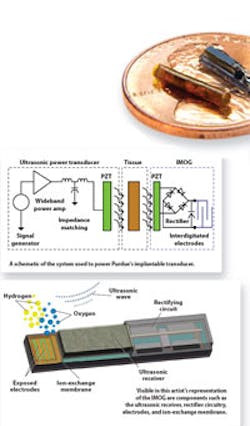Purdue implantable oxygen generator harvests power from externally applied ultrasonics
|
Resources: |
Purdue University researchers have devised miniature transducers that are implanted in tumors to generate oxygen, boosting the killing power of radiation and chemotherapy treatments. The devices get electrical power from ultrasonic waves beamed at them from outside the patient’s body.
The technology is designed to treat solid tumors that have little oxygen at their cores. Radiation therapy needs oxygen to be effective, so such tumors, which characterize pancreatic, cervical, and liver cancers, have proven hard to treat.
The oxygen generators were created at Purdue’s Birck Nanotechnology Center. Researchers have tested the devices in pancreatic tumors implanted in mice, showing they generated oxygen, which led to the tumors shrinking faster under treatment. The devices are slightly less than 1-cm long and are inserted into tumors with hypodermic biopsy needles.
Findings are detailed in a research paper appearing online in Transactions on Biomedical Engineering. The paper was written by research assistant professor Teimour Maleki, doctoral students Ning Cao and Seung Hyun Song, Indiana University School of Medicine assistant professor of clinical radiation oncology Song-Chu (Arthur) Ko, and professor of electrical and computer engineering and biomedical engineering Babak Ziaie.
About the Author
Leland Teschler
Lee Teschler served as Editor-in-Chief of Machine Design until 2014. He holds a B.S. Engineering from the University of Michigan; a B.S. Electrical Engineering from the University of Michigan; and an MBA from Cleveland State University. Prior to joining Penton, Lee worked as a Communications design engineer for the U.S. Government.

